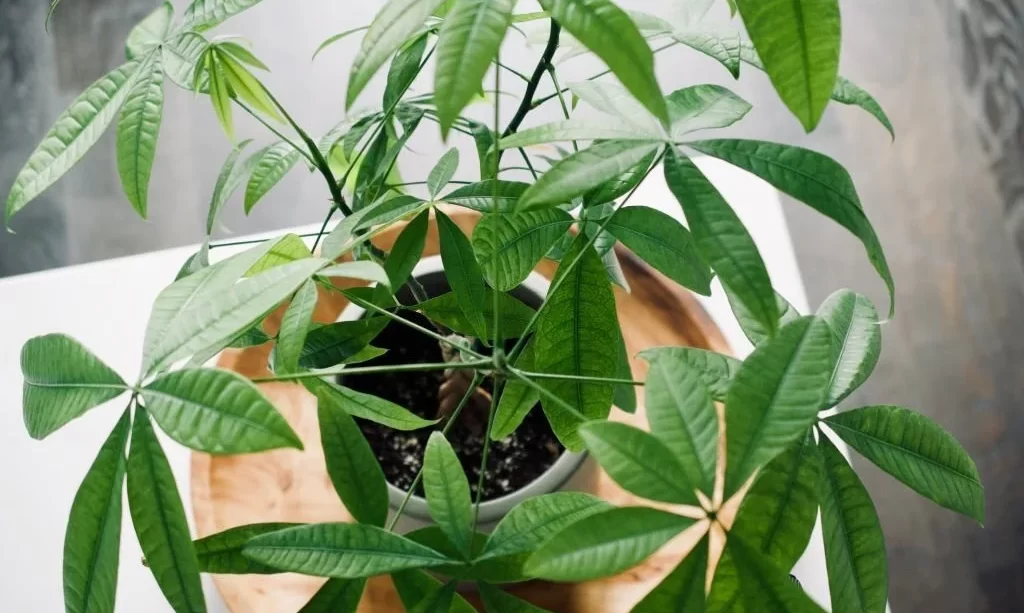The money tree (Pachira aquatica) stands as a beacon of fortune and abundance in the world of houseplants. With its distinctive braided trunk and lush, palm-like leaves, this captivating plant is not only a charming addition to any indoor space but also a symbol of prosperity and financial well-being. Yet, like any living entity, the money tree requires care and attention to thrive. One essential aspect of its care is knowing when and how to replant or repot it.
In this guide, we’ll embark on a journey to uncover the secrets of successfully replanting your money tree. Whether you’re a seasoned indoor gardener or a beginner seeking to harness the plant’s auspicious qualities, understanding the art of repotting is a crucial step. From recognizing the signs that indicate it’s time to repot to selecting the right pot and soil mix, we’ll explore the steps and considerations to ensure your money tree continues to grow, thrive, and bring prosperity into your life.
- Hand Blended Money Tree Soil- Hand blended soil perfect for growing money tree plants, Great for repotting or planting money trees.
- One Gallon Bag- One gallon of money tree soil is great for planting or re-potting money trees you buy at the big box stores. This quantity of soil is enough to plant 1-2 medium money trees.
- Great for Replacing Original Soil from the Store- Many times the soil a money tree is purchased in is slim on nutrients, and while it’s okay from seedling to growth, the same dirt you buy it in, is not going to allow your money tree to grow and become large and healthy.
- All Natural Ingredients- Peat, Bark Nuggets, Worm Casting, Perlite, and Lime. All Natural and well suited for growing your money tree.
- Size: 4 Quarts (1 gallon / 3.8 liters)
Knowing When to Repot
Before delving into the intricacies of repotting, it’s essential to recognize the key indicators that signal your money tree is ready for a change of home:
- Root-Bound Signs: One of the primary signs is when the roots of your money tree become visibly crowded, circling around the pot’s edges, or emerging from the drainage holes. This indicates that your plant has outgrown its current container, and it’s time to provide it with more space to spread its roots.
- Slow Growth: If you notice that your money tree’s growth has slowed significantly, despite adequate care and ideal conditions, it may be struggling due to limited space for root expansion. Repotting can provide the plant with fresh soil and room to flourish.
- Visible Stress: Another telltale sign is when your money tree begins to show signs of stress, such as wilting, yellowing leaves, or a general decline in overall health. These symptoms may be indicative of root congestion or depleted nutrients in the soil.
Understanding when to repot your money tree is the first step in ensuring its continued vibrancy and prosperity. As we delve deeper into the repotting process, you’ll gain valuable insights into selecting the right pot, preparing the plant, and providing post-repotting care, all aimed at nurturing this symbol of good fortune within your home.
Choosing the Right Pot and Soil
Selecting the appropriate pot and soil is paramount to the success of repotting your money tree:
- Pot Selection: Opt for a slightly larger pot than the current one. Ensure the new pot has drainage holes at the bottom to prevent water from accumulating, which can lead to root rot. A pot that is about 1-2 inches wider in diameter than the current one is generally a good choice.
- Soil Mix: Money trees thrive in well-draining soil. Create a suitable soil mix by combining regular indoor potting soil with perlite or orchid bark. These additions enhance drainage and aeration, preventing waterlogged roots.
- Avoid Over-Potting: While a larger pot is necessary for accommodating the growing root system, avoid choosing a pot that is excessively large. Too much soil can retain excess moisture and potentially harm your money tree. Aim for a pot that offers room for root growth without overwhelming the plant.
- Simple, elegant, and modern cylindrical straight round planter pot with saucer and drainage hole.
- Small 6 Inch Planter Pot: 6″ Diameter x 6″ H, black & speckled tan/brown color. Potting Soil Needed: 0.5 gallons / 2 qt.
- Fitting/matching ceramic earthenware indoor planter pot; ceramic tray/saucer Included.
- Planter pot with drainage hole, mesh drainage net and protective scratch pad included.
- Hassle-Free replacement or refund if any damage or issues with the package or planter pot and saucers. Quick and satisfying resolution.
Preparing for Repotting
Preparation is key to a smooth repotting process:
- Timing: Plan to repot your money tree during its active growing season, typically in spring or early summer. Avoid repotting during the dormant winter months.
- Watering: A day or two before repotting, water your money tree thoroughly. This helps the root ball hold together during the transplant process and reduces stress on the plant.
- Gather Supplies: Prepare all the necessary tools and supplies, including the new pot, soil mix, gardening gloves, a trowel or scoop, and a clean, sharp pair of pruning shears or scissors for root trimming.
Repotting Your Money Tree
Now, let’s dive into the actual repotting process:
- Remove the Plant: Gently and carefully remove the money tree from its current pot. Gently tap or shake the pot if needed to loosen the root ball. If the plant is particularly stubborn, you can use a clean, blunt tool to ease it out.
- Inspect the Roots: Examine the root system for any signs of damage or overcrowding. Trim any circling or damaged roots with clean pruning shears or scissors. This encourages healthy root growth in the new pot.
- Add Soil: Place a layer of fresh soil mix in the bottom of the new pot. Position the money tree in the center and fill in the sides with additional soil. Ensure the top of the root ball remains at the same depth as it was in the old pot.
- Tamp and Water: Gently tamp down the soil to remove air pockets and provide stability. Water the newly potted money tree thoroughly to help settle the soil and promote root establishment.
- Return to Preferred Location: Place your freshly repotted money tree in its preferred location, which typically includes bright, indirect sunlight. Avoid direct sunlight, as this can scorch the leaves.
Repotting your money tree is a nurturing ritual that not only supports its growth but also symbolizes your commitment to fostering prosperity in your home. As you follow these steps, you’ll ensure that your money tree continues to thrive, gracing your living space with its vibrant green foliage and auspicious symbolism.
Post-Repotting Care
Caring for your money tree after repotting is crucial for its continued well-being:
- Watering: After repotting, water your money tree thoroughly but avoid leaving it in standing water. Ensure that excess water drains from the pot, as soggy soil can lead to root rot. In the weeks following repotting, monitor the moisture levels and water when the top inch of soil feels dry.
- Avoid Fertilizing Immediately: Hold off on fertilizing your money tree for a few weeks after repotting. Newly potted plants are sensitive, and introducing fertilizer too soon can stress them. Resume your regular fertilization routine once your money tree has acclimated to its new home.
- Maintain Consistent Environment: Place your money tree in its preferred location—bright, indirect sunlight—and maintain consistent temperature and humidity levels. Avoid exposing it to drafts or extreme temperature fluctuations.
- Pruning and Maintenance: Continue to care for your money tree by periodically pruning dead or yellowing leaves and dusting its foliage to keep it clean and healthy.
- 🌱 PERFECT BLEND OF NUTRIENTS – Give your money tree plants everything they need to grow up healthy! Our 3-1-2 liquid concentrate has all of the essential nutrients that your plants crave.
- 🌱 MIX WITH WATER – Designed to blend with water to provide a single application to use every other watering cycle. 1-2 tsp per 8 cups water.
- 🌱 SUITABLE FOR ALL VARIETIES – You can use our fertilizer on just about any kind of money tree plant. It’s great for seedlings and mature plants alike.
- 🌱 SPECIALLY DESIGNED PREMIUM FORMULA – Special blend enables maximum absorption for plant growth and vitality.
- 🌱 DURABLE PACKAGING – This liquid concentrate comes in a sturdy, 8 oz sealed bottle. Store it in a safe, dry place and you can count on it to stay in great condition for a long time to come.
Troubleshooting and Common Issues
Even with proper care, challenges may arise:
- Transplant Shock: Your money tree may experience some shock after repotting. This is normal and temporary. Maintain a stable environment, and the plant should recover within a few weeks.
- Overwatering: Be cautious not to overwater your money tree after repotting. Ensure that the new soil mix provides adequate drainage to prevent waterlogged roots.
- Yellowing Leaves: Some yellowing of lower leaves after repotting is typical as the plant adjusts to its new conditions. Remove these yellow leaves to encourage healthy growth.
- Slow Growth: It’s common for a money tree to show slow growth immediately after repotting. Be patient; as it settles into its new pot, growth will gradually resume.
Conclusion
The process of repotting your money tree is a significant step in its care journey, symbolizing your commitment to nurturing its prosperity within your home. By recognizing the signs that indicate it’s time to repot, selecting the right pot and soil, and following the steps outlined in this guide, you ensure that your money tree continues to thrive and bring good fortune to your living space.
Remember that repotting is a form of investment in the future growth and well-being of your money tree. As it acclimates to its new environment, your efforts will be rewarded with lush, vibrant foliage and the enduring symbolism of abundance and prosperity that this remarkable plant carries.
With proper care and attention, your money tree will stand as a living testament to your commitment to a thriving, prosperous, and harmonious home environment.






